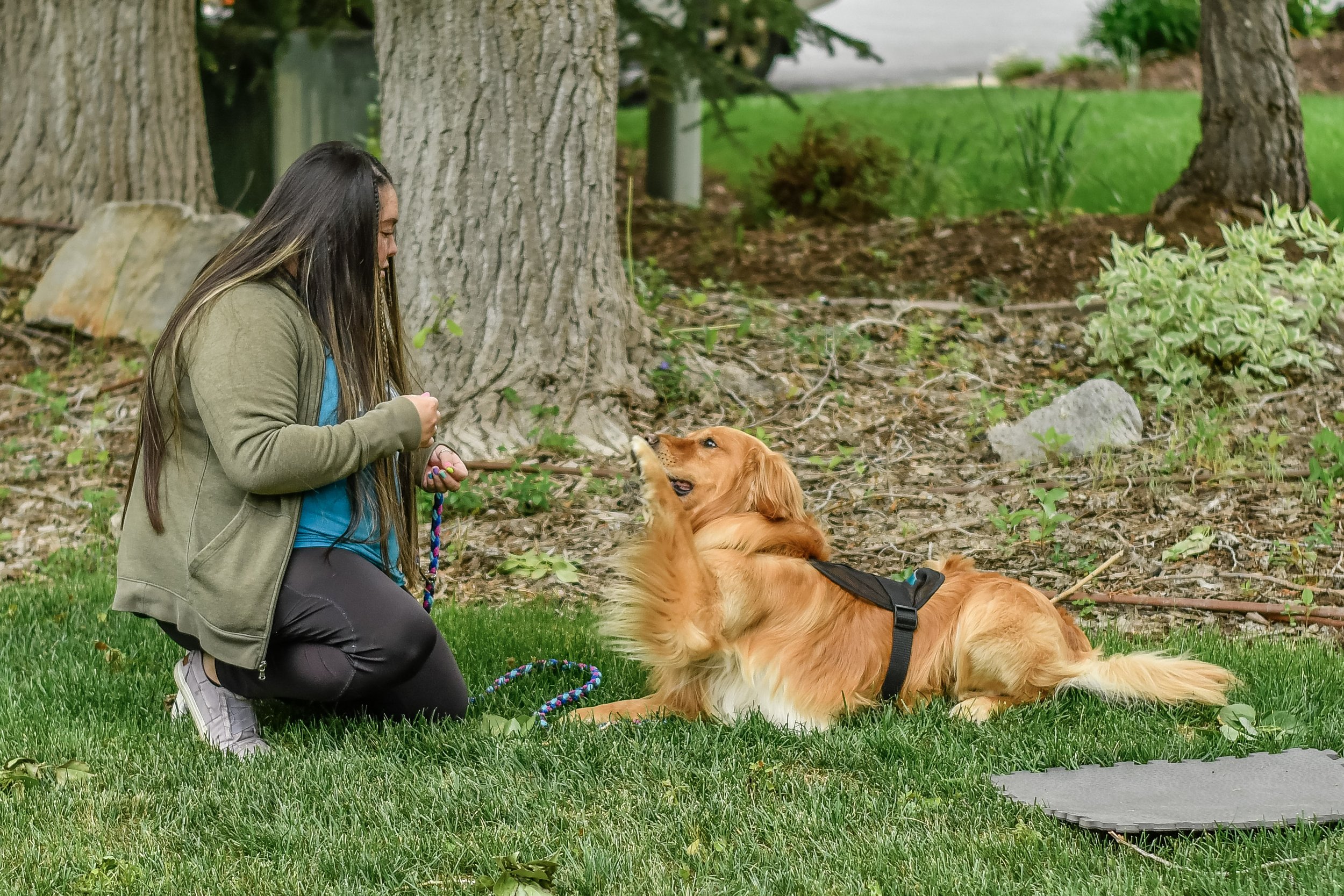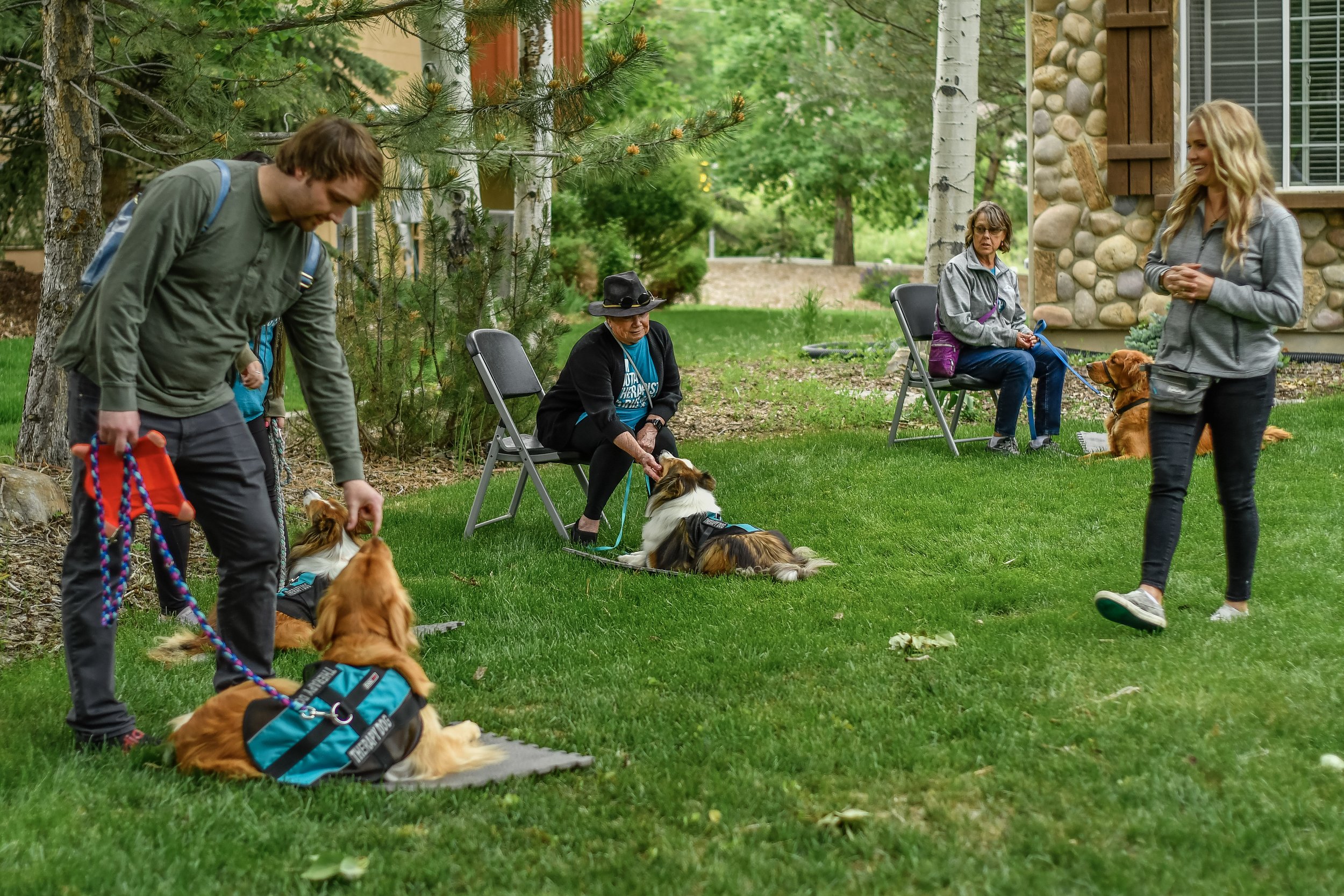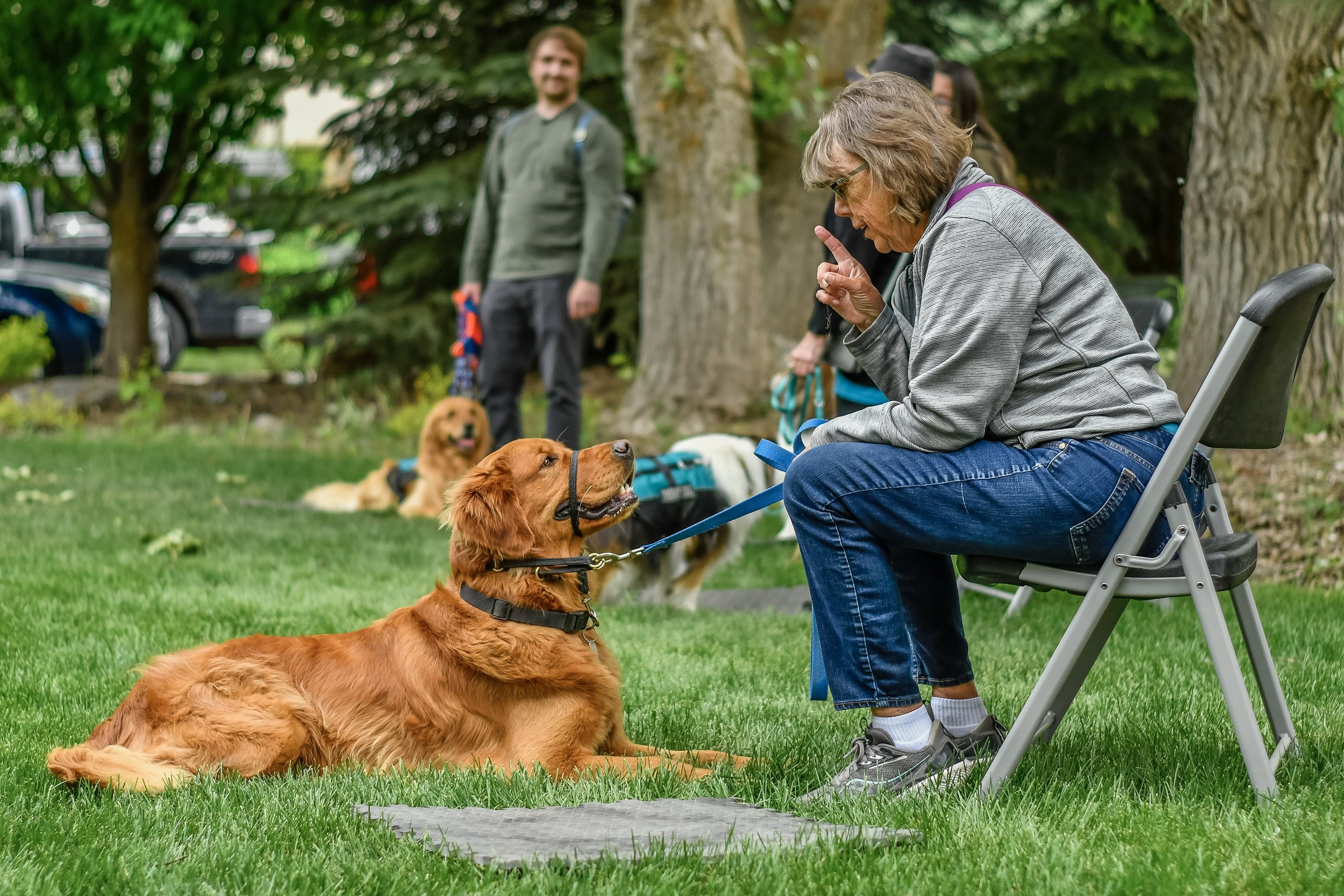
Certification & Training
RMTD Certification Test Requirements
-
Health Documentation & Appearance
The handler provides up to date vaccination records and proof of a city license (hard copy ONLY to save in the team's volunteer file). The evaluator examines the dog's appearance and determines they are in good health based off weight, energy level, condition of skin and/or fur, overall appearance, etc.
A dog that exhibits any sign of illness will not be allowed to test and must reschedule for a future date when their dog is cleared and healthy. A female in heat may be tested if approved by the evaluator. -
Basic Obedience
The handler will be asked to have their dog perform the following basic obedience commands. Verbal repetitions must stay to a minimal and harsh corrections and/or physical force are NOT ALLOWED.
1. Sit
2. Down
3. Stay (20 feet back and forth)
4. Come (20 feet away) -
Leaving Objects Alone
The evaluator will place a dog toy and treat of their choosing on the ground. The team will walk around those items within a 10 foot diameter until instructed to stop. They are allowed to utilize basic obedience commands as well as "attention getting noises" to keep the dog's focus off the resources.
The dog is allowed to sniff and show minimal interest in the toy and treat, however, cannot pull their owner to the objects. -
Meeting a Stranger
(Part 1) A stranger will calmly walk up to the handler, shake their hand, and exchange pleasantries. During the interaction the dog must stay calm. Light sniffing is acceptable, however, this exercise is to demonstrate that they are capable of staying relaxed while their handler engages with new people.
(Part 2) The stranger will ask to pet the dog. They are allowed to wiggle and calmly engage with them, however, cannot get overly excited. They will pet the top of the head, ears, pads, back and tail.
(Part 3) The stranger will stand up from petting them, circle around the team and walk away. During this time the handler must keep the dog relaxed and focused on them. They dog is not allowed to pull on the leash in attempt to follow or continue engaging with the stranger. -
Accepting a Hug
This test demonstrates the dog is comfortable being hugged by a person, which is a common form of interaction in therapy work. The evaluator will approach the team and ask permission to pet the dog. The handler is allowed to manage the interaction and explain to the stranger how the dog prefers to be hugged. They dog must experience some form of restraint approved by the evaluator in order to pass.
Pulling away or freezing up are not acceptable behaviors during this exercise. -
Taking a Treat Politely
They dog will be offered a treat by the evaluator. If they choose to take it, they must do so gently without snapping or biting down on the hand. The dog can still pass this test item without accepting the treat as long as they are well mannered around the door.
The owner is allowed to provide the treat if their dog has dietary restrictions. -
Walking Through a Crowd
At least three volunteers are required for this test item. They will walk tightly around each other to simulate a busy sidewalk or crowded hallway. The team must weave around them until told to stop. -
Crowded Petting
The dog will be approached by a team of at least three people. They will then begin to engage with the dog by appropriately petting them and trying to get their attention in an excited manner. The owner may control the interaction by instructing the strangers how the dog prefers to be pet. They evaluator may increase the intensity of the interaction if the team is enjoying it. -
Reaction to Distraction
Visual - The evaluator will start by having a stranger move around the dog (approximately 5 feet in diameter) using some form of medical equipment (ex: wheelchair, walker, or crutches). The dog is allowed to show minimal interest but may not jump on, become over-exuberant, or show signs of fear/ anxiety.
Noise - The evaluator will create a loud noise (ex: dropping a pile of books on the ground) 5 feet from the dog. They may display initial signs of being started (freezing, moving away, barking no more that a few times) but are expected to recover quickly. -
Role Play
The following exercises are designed to demonstrate the dog's ability to accept and/or tolerate a variety of circumstances they may come across while working.
(a) Excessive and clumsy petting: This test will demonstrate a dog can be comfortable working around people with limited physical abilities or for those who do not know how to appropriately interact with dogs. A stranger will use clenched fists, elbows, high pitched squeals, clapping and clumsy movements while petting and engaging with the dog. The dog should not show a decrease level of enjoyment or stress signals during this interaction.
(b) Angry yelling: This test will demonstrate your dog will not become upset around people with strong emotions. Two people will begin to shout in an angry manner toward each other and wave their arms around frantically. The dog can appear startled, however, must be able to maintain appropriate behavior and recover quickly.
(c) Medical Equipment Manners: This test will demonstrate that the dog can engage appropriately around people with injuries or limited physical abilities. The stranger will approach the team using a wheel chair, walker or crutches and ask to pet the dog. They may not jump on, be over-exuberant or show signs of fear/ anxiety. -
Dog Interactions
(a) Initial Response: The team will see another dog 25 feet away. The testing dog is allowed to show initial excited behavior, however, must be easily redirected and calmed down by the handler. They are expected to then just show casual interest in each other. An initial bark is acceptable as long as it is not paired with aggressive body language. (Determined by the evaluator)
(b) Moving Past a Dog: The teams will then move toward each other and pass by with no more than 6 feet of space between them and walk to the space where the other dog last stood. The dog should be easy to manage on leash and show no more than slight interest in the other dog.
(c) Close Proximities: The evaluator will mark two spots for the teams to walk to (6 feet apart). When they arrive, the dog must be placed in a sit or down stay and remain relaxed until told to stop. The dog should show no more than slight interest in the other dog. -
Supervised Separation
The handler will bring their dog up to a stranger and hand them the leash. They will then be instructed to walk out of sight for 2 minutes. During their absence, the dog is allowed to show minimal signs of concern or stress, however, must be easy for the stranger to manage. The stranger is not allowed to offer an excessive amount of praise/ thought with the intent to distract them from their owners departure.
RMTD’s commitment to positive reinforcement techniques ensures that our therapy dogs are not only well-behaved, but also empowered to make a significant difference in the lives of those they serve.
Our comprehensive educational program is designed to provide a solid foundation for our teams. It consists of three group classes that cover a wide range of topics, starting from basic obedience and progressing to advanced work in public settings. This meticulous approach effectively prepares our teams to excel in RMTD's rigorous 12-point certification test, setting them up for success in their therapy dog endeavors.
Once certified, our teams gain access to essential benefits, including insurance coverage, and are thoughtfully designated to work in one of two categories:
Dog Assisted Therapy (DAT) Teams work with health care providers, social workers and other professionals to assist with goal-oriented therapies, typically with individual patients or clients.
Dog Assisted Activity (DAA) Teams work in group settings like nursing homes, hospitals, schools, homeless shelters and countless other places where interaction with Therapy Dogs brings positivity and joy.
Our passionate team of professional dog trainers is committed to providing comprehensive support to our teams throughout their certification journey. We understand the importance of continuous learning and growth, which is why we offer free monthly get-togethers for all our members.
During these enjoyable and interactive gatherings, we focus on refreshing and honing fun and useful behaviors that can be utilized during therapy dog work. From teaching our furry companions to turn pages of a book with their nose to helping them exude bashfulness to comfort shy clients, these specialized techniques enhance the therapeutic experience for both our dogs and the individuals they serve!

GROUP CLASSES
Calling all dog owners and their enthusiastic dogs. Join our obedience classes and embark on an exciting journey of learning, bonding, and empowerment! 🐾
BASIC OBEDIENCE
Price: $220
Duration: 7 weeks (includes a dog-free handler orientation)
Locations: Park City and Kamas
Details: Discover the perfect class tailored for young and inexperienced dogs, where they will learn all the fundamental obedience cues through effective and positive reinforcement methods.
Contact us directly to learn more about the class material, dates, and availability!
INTERMEDIATE TRAINING
Price: $235
Duration: 6 weeks
Locations: Park City and Kamas
Details: This program serves as the perfect transition to advance your dog's skills, and we've compiled a series of engaging games to make the learning process fun and exciting for both you and your furry companion.
Contact us directly to learn more about the class material, dates, and availability!
ADVANCED COURSE
Price: $250
Duration: 6 weeks
Locations: TBD
Details: This dynamic program takes our teams on an adventure all around the community, where we fine-tune behaviors amidst the most challenging distractions. Get ready to elevate your dog's training to new heights in real-world settings, mastering obedience skills with the guidance of our expert trainer.
Contact us directly to learn more about the class material, dates, and availability!

Testimonials
“Willow and I are honored and excited to be a part of an amazing program in our area. I have always enjoyed being of service to whomever needs it, and this is a great way to do that with a fluffy companion.”
“Going to the places that RMTD teams are at and seeing the work they do has been therapeutic for me as well. I am grateful for any part that I have been, and will continue to do with them. ”
“Amy Francis combines her love of people and her expert dog training skill and knowledge in this great new non-profit that benefits people and dogs alike. Her passion in this endeavor is evident. Anyone wanting to participate in therapy work with their dog should check out Rocky Mountain Therapy Dogs!”
“
Judy & Charlie
“With patience and professional training from Amy Francis, Charlie is ready for his journey as a therapy dog for Rocky Mountain Therapy Dogs! I couldn’t be more appreciative for all that Amy and her team have done for us and for the community!”
JAN & Nova
“We’ve been involved in [numerous organizations] for 15 years with 4 different dogs. Amy has taken her dream of having a non-profit therapy dog group and made it a reality. Her skill as a dog trainer and having EVERYONE train together as a group, assisted by her volunteers and trainers, makes a world of difference when it’s time to test. Other organizations philosophy is: Give me your money and try and pass our test. Our dogs well being and safety come first in RMTD. It’s a small but MIGHTY group that will expand into GREATNESS! Come join us!”



